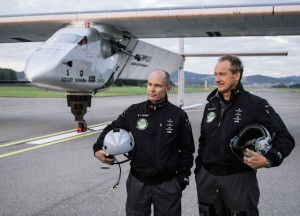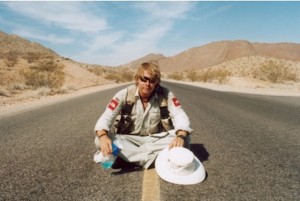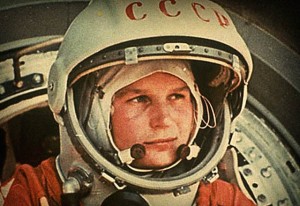The first man to ever achieve this was not actually Magellan, like it is commonly believed, since he died in the Philippines, before reaching his starting point in Spain. The man who should be credited however is Juan Sebastian Elcano, the captain of the only surviving ship of that same voyage. Nevertheless, there are still people out there today who have taken it upon themselves to achieve this same extraordinary feat. Not all of them have done it on sailing ships, some being quite original in their method of travel. Here are some of these people.
10. Robert Garside – Ran Around the World

Also known as The Running Man, Robert Garside is a British athlete who ran a total of 35,000 miles in over five years and eight months and won the title of the first man to do so, given to him by the Guinness World Records. His journey took him on all continents, with the exception of Antarctica, and he ran through 30 countries after setting off in New Delhi, India in 1997.
In his long journey he had his share of bad luck, and more than once. He was chased off by people in an Indian village, shot at by a group of Russian Gypsies, highjacked at gunpoint in Central America, jailed in China on charges of espionage, and so on. He also had to endure scorching heat or freezing temperatures, depending on where he was. He nevertheless met the love of his life, Endrina Angarita Perez, in Caracas, Venezuela. Together they ran through Africa in the wake of 9/11 and made it a race against the clock to pass the Middle East before the controversial Operation Iraqi Freedom began.
9. Laura Dekker – Sailed the World Alone at 14

Laura Dekker is the youngest person to have circumnavigated the world all alone and without aid from anyone. She began her journey at Gibraltar in August of 2010 and one and a half years later she arrived at Saint Maarten, in the Caribbean, on January 21, 2012. She did it by sailing a 30 year-old, 38 foot yacht called Guppy.
Laura was born in 1995 in Whangarei, New Zealand during a seven year sailing trip by her parents. Her father was a boat builder and her mother a street performer. After her birth, the family travelled for another five years before returning to Holland. She started sailing alone as early as six years old, both around the Netherlands and the North Sea. In 2009 she made a sailing trip to England and that’s when she decided to circumnavigate the planet.
Things would come to a grinding halt for the next 10 months however, as the Dutch government was opposed to her leaving. She was even taken away from her parents by the authorities in order to stop her from leaving. Nevertheless, custody of Laura was given back to her parents in July of 2010 and one month later she was already on her way.
After reaching her destination in Saint Maarten, she left for her birth place of New Zealand and has lived there ever since. She was happy to exchange the Dutch flag on Guppy with the New Zealand one.
8. Bertrand Piccard & Brian Jones – In a Hot Air Balloon

Back in 1999 something that was previously thought of as being impossible, happened. Bertrand Piccard, 41, and Brian Jones, 51, were able to fly over the entire Earth in a hot air balloon, at an altitude of 36,000 feet and with no pit stops, and all in a little less than 20 days. There had been 21 previous attempts made in the years prior to this expedition and most aeronautic experts said it couldn’t be done. But this time the mission was a success, and with just 40 kilograms of remaining fuel. This much, out of the original 3.7 tons, was enough for only one more extra day of flight.
The journey took them over Europe, Africa, Asia, the Pacific Ocean, Central America and the Atlantic Ocean and at 10:54 A.M. (4:54 A.M. Eastern time) they crossed the 9 degree, 27 minutes west longitude over Mauritania, the longitude from which they began their 20-day voyage in Switzerland. They hoped to land their airship next to the pyramids in Cairo, but unfortunately the winds blew them southward. The cost of the mission is not exactly known, but we do know that the Breitling Orbiter 3, built by Cameron Balloons Ltd. of Bristol, England was somewhere around $2 million.
7. Mike Hall – Cycled the Globe in Record Time

Mike Hall is a British engineer and also the fastest man to ride his bike around the world. He began his epic race in 2012 and 107 days later he arrived to the exact same point, but coming from the opposite direction. Well, to be honest, he didn’t ride for 107 days but rather 92, while the rest was spent in airplanes, changing continents, since it’s decidedly difficult to ride a bike across an ocean. This puts him in the lead by at least several weeks, as compared to the next one in line.
He made an average of about 200 miles per day, cycling in all sorts of weather conditions and unforeseen circumstances. His peddling took him through 20 countries, four continents and 18,000 miles, for 24,900 miles in total. On March 4, he crossed the finish line at Greenwich royal observatory in south-east London, just in time for his 31st birthday. He also won the longest mountain bike race, the Tour Divide, which comprised of a single stage unsupported race of 2,745 miles and 200,000 feet of ascent.
6. Bertrand Piccard & Andre Borschberg – Flying in a Solar Plane

The first ever completely solar powered airplane flew half way across the world earlier this year. It’s called the “Solar Impulse” and can fly both during the day and night, regardless of the weather conditions outside. The plane was designed and created by Andre Borschberg, who is an engineer and former fighter pilot, and psychiatrist Bertrand Piccard, who by the way was also the one who flew across the world in a balloon back in 1999.
Anyway, the aircraft cost somewhere around $140 million and has taken 10 years to design and build. It’s made out of carbon fiber and weighs about 3,500 pounds. Its power comes from the 17,000 solar cells mounted on its wings, which charge a series of batteries. The plane uses no other sources of power and is made as a statement for an alternative and greener way of travel. A standard commercial airliner burns up to a gallon of kerosene per second, which adds up to roughly about a ton of CO2 in the atmosphere for a flight from Los Angeles to New York.
Solar Impulse is just a test plane, if you will. It’s minimal to all it has to offer, including its four small electric engines, which produce only about 10 horsepower. This is similar to what the Wright brothers were flying back in the day. The cockpit is not heated or pressurized and the pilots have to wear oxygen masks and parachutes during the entire voyage.
So far the team has flown halfway across the world, leaving Abu Dhabi on March 9. After eight stages and almost four months, they reached Hawaii on July 3. With an average speed of about 39 miles per hour and a general altitude of about 28,000 feet the Solar Impulse is more of a glider than a plane. Nevertheless, it’s a step in the right direction. The next stage of the flight was unfortunately postponed to 2016, when the team will pass over the rest of the Pacific, North America, the Atlantic, and Mediterranean, landing down back in the United Arab Emirates.
5. Lt. Lowell Smith, Lt. Leslie Arnold, Lt. Erik Nelson, Lt. John Harding – First Ever Flight

The Solar Impulse above is nice and all, being the first solar plane to go around the world, but the first aerial circumnavigation was done by two US army Douglas DWC amphibian planes called ‘Chicago’ and ‘New Orleans’. The ‘Chicago’ was piloted by Lt. Lowell Smith and Lt. Leslie Arnold, the ‘New Orleans’ by Lt. Erik Nelson and Lt. John Harding.
The journey took 371 hours and 11 minutes with a total of 57 stops across the world. They started off on April 6 and returned to Seattle, Washington on September 28, 1924. Originally Lt. Leslie Arnold wasn’t even supposed to take part in the flight, but because Sgt. Arthur Turner became ill just four days before the start, he was chosen as the replacement.
Nevertheless, their flight didn’t take them in both hemispheres of the world, and that title goes to the Australian, Charles Kingsford Smith in 1929. He is also the one who first made the nonstop trans-Pacific flight in 1928.
4. The RMS Laconia – Cruising the World

Eleven years after the Titanic disaster, which took place in the North Atlantic on the night of April 14 through to the morning of April 15, 1912, the RMS Laconia was the first ever around-the-world cruise, beginning its journey in early January of 1923. With its twin propellers the RMS Laconia had an average speed of 16 knots, making the trip in 130 days, and calling into 22 ports along the way for its 2,200 passengers onboard.
The cruise liner, however, is known for a totally different reason altogether. During WWII, the RMS Laconia, carrying some 2,732 crew, passengers, soldiers and POWs, was torpedoed and sunk by a German U-boat off the coast of West Africa. Following the old prize ruleswhen it comes to marine warfare, the U-boat captain immediately commenced rescue operations, broadcasting their humanitarian intent on open radio channels to all Allied forces in the area.
Despite this, the submarine was attacked by a USAAF B-24 Liberator bomber, just as the foredeck was full of rescued survivors. Many died during the attack and the rest were thrown overboard as the submarine had to crash dive in order to avoid being blown up. After this incident the German Navy forbade all attempts to rescue stranded Allied seamen. During the Nuremberg Trials after the war, Grand Admiral Karl Dönitz of the German Navy brought up the Laconia Incident, embarrassing the US forces, which tried to forget the whole affair as fast as possible.
3. Karl Bushby – Hiking From South America to England

In what is known as the Goliath Expedition, former British paratrooper Karl Bushby from Hull, England began a challenge to complete the longest continuous walk in human history back in 1998. With only $300 Bushby set off on the 20 plus year, 36,000 mile journey from the Southernmost tip of South America, through Central America, the West Coast of the US and Canada, through Alaska, across the Bering Strait and into Russia. The mission is to cross both the Asian and European continents and reach his hometown of Hull.
However, more than a decade after he started and halfway through his epic journey, he was arrested by the Russians for literally swimming into the country and landing into an abandoned military base in the Kamchatkan Peninsula. They placed a restriction on his visa for the next five years and left Bushby wondering if he would ever be able to accomplish his dreams.
Then, in 2013 a pair of filmmakers approached him and came up with the proposal of walking 3,500 miles from LA to Washington DC in order to resolve his visa issues with the Russian embassy there. With the mounting tensions between the two governments during the Crimean crisis of 2014, things seemed hopeless. Then, thanks to an article about theGoliath Expedition in the Washington Post, new life was brought back to the journey.
His visa ban was lifted and he resumed his journey through the Siberian wilderness. He was, however, given permission to only stay in the country 90 days at a time, so he has to go back and forth between Siberia and Europe. His next milestone is to reach The Road of Bones, which marks the end of the Arctic and a continuous paved road journey from there all the way home.
2. Jason Lewis – Expedition 360

Expedition 360 is the first true circumnavigation of the world done entirely with human power. This means that there are no motors, engines, sails, or anything else that doesn’t involve using your muscles to move forward. This sounds a lot like the Goliath Expeditionfrom above, but the difference here is that there isn’t just walking. As means of transportation, there are also bicycles, roller blades, swimming, kayaks, and pedal powered boats.
Jason Lewis, now 48, is the first to complete this challenge. He and his team began the journey in 1994 and 13 years later they were back where they started off, on the Greenwich line in London. They left London on bikes up to the English Chanel, a pedal boat across to France and again on bikes all the way to Portugal. From there they used that pedal boat again across the Atlantic to Miami and roller bladed the whole continental US to San Francisco. In Pueblo, Colorado, he was struck by a drunk driver and had to spend nine months in the hospital, due to having both his legs broken. This didn’t stop him and by 1996 he reached the West Coast.
From here, they went down the Pacific coast into Mexico on bikes and all the way to Tegucigalpa in Honduras, when they had to turn back because of the severe El Nino weather effects in 1997. From San Francisco, they peddled to Hawaii and then island-hopped to Australia. Here Lewis mountain biked 3,500 miles through the Australian outback, pedal boated from there to East Timor, kayaked to Singapore, biked trough southeast Asia and Tibet over the Himalayas and into India. He then pedal boated again from Mumbai to East Africa over the Indian Ocean, then biked through Sudan and Egypt, the Middle East, Turkey, and eventually back to England.
Before the Atlantic pedal boat leg of the challenge, both Lewis and his fellow adventurer Stevie Smith had just about four days experience on a boat. By the end of the 13 year journey, they were both experts, even if Smith ended his adventure in Hawaii.
1. Yuri Gagarin – The First Man to Orbit the Planet

Okay, this may be considered by some as not really counting as circumnavigating the planet because Yuri Gagarin was in outer space. But even so, his journey was something truly amazing and which will be forever remembered in the history books. Going around the planet is going around the planet, regardless of how high up you do it. He was the first man to ever go into space and see the entire planet as a whole. He did this on April 12, 1961 in the Soviet Vostok 1 Spacecraft. His flight lasted for 108 minutes, 89 of which were spent in space orbiting the planet. This may also count as the fastest circumnavigation in this list.
Since then, many other astronauts have left the planet and circled the world. The International Space Station (ISS) travels at a speed of 7.66 km per second and sees a sunrise every 92 minutes, and there’s always somebody up there.
All of these men and women we talked about up to this point, not only Yuri Gagarin and the other astronauts that came after him, but everybody who encircled the planet in one way or the other, had a different perspective on things once they came back. Psychologists, neuroscientists, and physicians have all reported a notable shift in behavior and outlook on life in all astronauts who ever went into space and encircled the planet. The same is true for the others who’ve done it closer to the planet’s surface.
To end this list, we leave you with a quote from the astronaut Edgar Dean Mitchell, who described what he’d seen and felt when he saw Earth from the Moon: “You develop an instant global consciousness, a people orientation, an intense dissatisfaction with the state of the world, and a compulsion to do something about it. From out there on the moon, international politics look so petty. You want to grab a politician by the scruff of the neck and drag him a quarter of a million miles out and say, ‘Look at that, you son of a bitch.”
0 ความคิดเห็น:
แสดงความคิดเห็น